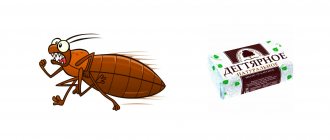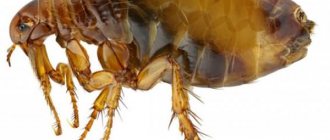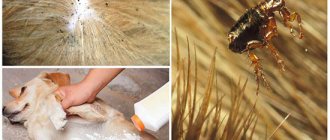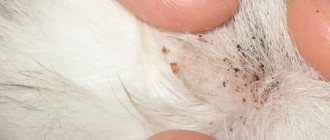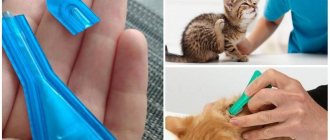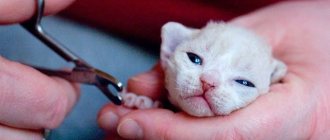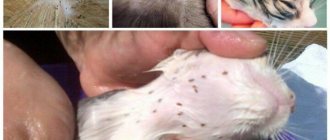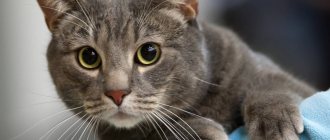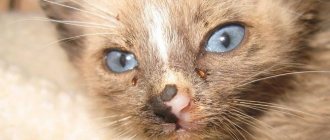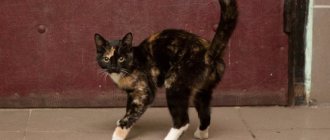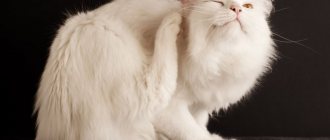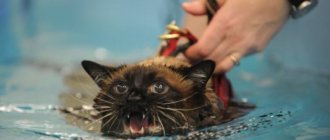What is tar soap
Tar soap is available in solid and liquid versions and in a short time relieves four-legged pets from the attacks of malicious parasites. More often it is used in solid form and is a block with a dark brown color.
Tar soap is dark brown in color.
Composition of the substance
The active effect of this product is explained by its composition, where the role of the main ingredients belongs to:
- Birch tar is a natural antiseptic, the content of which in soap is about 10%.
- Sodium salts, which normalize the water-salt ratio of the skin.
- Alkalis, phenol, cresol. These components are dangerous due to their tendency to cause chemical burns. Together with birch tar, such substances can destroy insects.
What is the spectrum of action of soap?
This product has:
- drying effect;
- the ability to heal wounds;
- disinfectant properties.
Drying of the skin, healing of existing cracks, wounds, cell renewal occurs thanks to the main substance of this soap - tar, which also stimulates metabolic processes and blood flow to the skin.
Tar soap has a number of useful properties
How the product works
The whole secret of the effective action of tar soap lies in its inherent smell, which repels small insects that cause considerable discomfort to four-legged pets. This remedy can drive away mature individuals and eliminate their larvae. The resinous product found in soap, tar, leads to the death of microorganisms and pathogenic fungi. Insects cannot tolerate tar odors, which lead to paralysis of the nerve impulse centers of parasites and the cessation of their vital functions.
The secret of the effective action of tar soap lies in its smell.
Safety of soap for cats and humans
This soap is not a chemical agent (insecticide), so its use is safe for all cat breeds, as well as for people taking part in the procedure for eliminating parasites from pets.
Soap containing tar has been known for a long time. They treated wounds; pregnant and lactating cats; small kittens (from 1 week of age). Various insecticides and anti-flea collars are allowed to be used by babies only from the age of two months, so as not to cause them harm.
Why does tar soap repel insects?
Owners of furry creatures, encountering bloodsuckers for the first time, are wondering about the advisability of tar soap. Over the past two decades, veterinary science has made great progress. However, a simple drug is still used to this day in solving the flea problem and helps well.
The main element is birch tar. A viscous, sharp-smelling liquid with an oily black consistency. It is released when birch bark is steamed in special boilers. Gives the detergent a specific odor that is intolerable to fleas.
By repelling bloodsuckers, tar fights skin diseases, bacteria, and fungus. Improves the condition of the epidermis and coat, heals superficial abrasions and scratches. In addition to the listed areas, it is used in the treatment of sore throat, osteoporosis, respiratory tract, benign and malignant tumors.
Tar soap is available in solid and liquid versions. In addition to tar, the composition includes sodium salts, citric acid, and auxiliary substances.
Tar soap is available in solid and liquid versions
Pros and cons when used against parasites
Tar soap against fleas in cats is an excellent alternative to expensive chemicals.
The main advantages of using this soap to rid cats of fleas:
- has a positive effect on the condition of the cat’s skin and coat;
- heals small wounds from flea bites on the skin;
- all components in tar soap are completely natural, so it can be safely used to get rid of fleas from weakened, pregnant cats and kittens;
- can be used an unlimited number of times;
- the price is many times lower than the cost of professional flea products.
Tar soap as an anti-flea agent for cats, along with its advantages, also has some disadvantages. True, in comparison with the advantages, the disadvantages turn out to be quite insignificant.
Disadvantages of using tar soap for fleas in cats:
- a sharp, specific smell can be unpleasant to both cats and people;
- extremely rarely, but in some animals tar provokes allergic reactions;
- Soap should not be used for cats that have dry and thin skin. Otherwise, the skin will become even drier and small cracks may appear on it;
- It is not possible to get rid of fleas after the first application, so you have to re-treat;
- When using tar soap, the cat must be washed. In most cases, this is quite difficult, because representatives of the cat family, as you know, do not like water procedures.
What soap will help fight fleas
Tar soap effectively destroys fleas - this is confirmed by numerous reviews. The product treats the skin after parasite bites. Its main advantage is safety for the animal and the owner. Even pregnant cats and kittens can be treated with this substance. People use this drug to kill lice.
The principle of operation of the product is simple - the active components of the soap paralyze the nerve centers of parasites, stopping their vital functions. The main ingredients of the drug destroy fleas and have a healing effect on the skin after bites of harmful insects. Very rarely, the drug causes minor side effects.
After bathing an animal with tar soap, its skin and fur may dry out a little. By licking the remaining substance after a hygiene procedure, the cat or dog will not have any unwanted reactions. If your pet lives in an apartment, then the rooms must be treated against insects.
A simple way to get rid of parasites on animals or in an apartment is to destroy them with an effective means. At home, a tar, household or dust product can cope well with this.
Degtyarnoe
Fleas feed on human blood, and the smell of tar repels them. Fleas bite animals severely and for them it is unbearable pain, because wounds form on the pet’s body. Cats scratch wounds with their claws and thereby cause inflammation. Tar soap not only destroys parasites, but also relieves skin inflammation.
Dustovoe
This is a common household toxic substance that can kill fleas. In a certain concentration, it can kill parasites even in eggs, and not just in adults. The dust substance is effective because it destroys even larvae. Insects either leave the hairline or die if they remain on it.
It is enough to treat the animal with this drug once to rid it of parasites. Often using dust soap against fleas on dogs is not recommended due to increased toxicity.
Economic
Inexpensive detergent with a wide range of applications. Laundry soap was previously used to wash dishes, body and head, or wash clothes. This substance is also used to combat parasites. But soap does not kill them, but repels them with its smell.
Composition of the drug:
- potassium or sodium salt;
- fatty acid.
Laundry soap is an environmentally friendly and natural product. The product foams well even in cold water.
With celandine
Together with tar soap, you can use laundry soap or modern insecticides. For example, bathe the animal immediately with soap and then with a special anti-parasite shampoo. Complex treatment ensures that the fleas die.
Instructions for use
Cats are famous for their dislike of water. For this reason, removing fleas using tar soap will require the participation of two adults. One needs to hold the cat tightly, and the second will soap and rinse the animal.
The procedure will be successful if all actions are performed sequentially:
- Pour warm water into a bathtub or basin at a temperature no higher than 38-43°C. You should not bathe your cat with cold water: he may catch a cold.
- Place the animal in the water so that it reaches the chest and does not rise higher.
- Wet the wool. You can leave your head dry. The stomach of cats is a very sensitive place. Do not direct too strong a stream of water at it, otherwise the pet will get scared and begin to struggle.
- Gently but thoroughly lather the cat's body with tar soap.
- Wrap your pet in a towel and wait 10 minutes so that the tar has time to have maximum effect on the fleas.
- After this time, rinse the wool thoroughly with warm water.
- Wrap the cat in a clean and dry towel.
- After the pet is dry, use a fine-toothed metal comb to comb out any remaining fleas and their larvae from its fur. It is best to do this on newspaper or some kind of bedding that can be thrown away along with the parasites.
It is important! Treating your cat against fleas with tar soap should be done 2-3 times every 4-5 days.
When you urgently need to wash your cat
Cats are capable of taking care of their own cleanliness. They lick their fur several times a day; this behavior is inherent in them by nature. However, there are times when a pet requires additional water treatments. Sometimes the animal needs to be washed urgently. Then the owner is faced with the question: “Is it possible to bathe a cat with regular shampoo?”
Urgent water procedures are necessary in the following cases:
- Pets are thoroughly washed before the exhibition. However, such situations rarely arise. Owners of purebred cats, as a rule, purchase in advance everything they need to prepare their pet for the event.
- If the animal's fur is very dirty and the pet cannot clean it on its own.
- If a toxic substance gets on your cat's fur, it needs to be removed immediately.
- Long-haired cat breeds require frequent washing during the shedding period. Otherwise, licking yourself can lead to hair getting into the stomach and indigestion.
- If the animal has parasites in its fur. But in this case, human shampoos will not help. Special veterinary products are required to remove fleas and ticks.
Precautionary measures
Despite the fact that tar soap rarely causes allergy attacks, before washing it is better to make sure that the cat does not have an individual intolerance to its components. To do this, apply a little product to a part of the body that is inaccessible to the pet, for example, the withers.
If after a day there is no reaction, then you can safely remove fleas from your cat with this soap.
It is better not to get your pet’s head wet at all, but keep it elevated during bathing so that foam does not get into the nose, mouth, ears and eyes. Accidental ingestion of foam may cause stomach upset.
You should not bathe cats with dry and thin skin too often with tar soap. They may experience irritation, peeling and cracking.
The sharp and unpleasant smell of tar soap can lead to dizziness, so it is better to carry out the treatment in well-ventilated areas.
Preventing the reappearance of fleas
After the fleas have been removed, measures must be taken to prevent them from appearing again. To protect your cat, you can sometimes bathe it with tar soap for prevention. You should also regularly clean your living space with soapy water. The fleas living in the apartment will not disappear immediately, but regular use of the product will remove them.
To prepare the solution, you need to dissolve tar soap in warm water - the more, the better. You can take a bar for a standard ten-liter bucket. Thoroughly wash the floors with the resulting mixture, paying special attention to the likely habitats of fleas:
- carpets,
- pets’ favorite resting places, their beds,
- sofas and armchairs,
- cracks in the floor, baseboards,
- place near the door (fleas often enter the house from the street or stairwell).
If asthmatics, allergy sufferers, pregnant women and children live in the house, it is better for them to leave the room before the treatment is completed, as the strong smell of the product can make them feel unwell. After washing the floor, you can ventilate the apartment. Tar itself is non-toxic, so if residents are not sensitive to its smell, it is not necessary to ventilate.
For anti-flea treatment at home, you can use a solution of concentrated birch tar.
Traditional methods of treatment
Folk remedies should be used only after prior consultation with a veterinarian. It must be remembered that such treatment methods may not always be effective, especially in the presence of a significant number of parasites. In order to achieve a positive result, it is recommended to use several methods at once.
Cats may be allergic to some folk remedies. It is important to monitor skin reactions during the procedure. If alarming symptoms occur (redness, itching, rashes, vomiting and diarrhea), you should abandon the chosen method and consult a doctor.
Mechanical method
This method is effective only when used in conjunction with anti-blade treatment. If you do not additionally use any anti-parasite remedies, this procedure will not bring any results. Therefore, before you start combing, it is recommended to treat your pet’s fur with any anti-blade shampoo or tar soap. The procedure should be repeated several times a day.
Algorithm of actions:
- Wear gloves. This is a prerequisite, otherwise you can get some kind of infection from fleas.
- Take a fine-tooth comb and comb the cat's fur against the direction of hair growth.
- Gently comb out the parasites, using your fingers to select the larvae, which most often attach closer to the skin. All fleas should be thrown into a jar of boiling water.
- After combing against the grain, you need to do the same only in the opposite direction (according to growth).
A total of up to 5 procedures may be required. It all depends on the method of removing parasites. Even if fleas are completely eliminated, it is necessary to comb out again after 7 days.
Combing fleas from a cat should be done with a special comb.
The mechanical method is not suitable for everyone. Your pet may not like this method because it takes quite a lot of time. This is especially true for active animals accustomed to constant play.
Tar soap
Tar soap is not only a safe, but also a useful way to get rid of fleas and has an antiseptic and wound-healing effect. To eliminate parasites, it is most convenient to use a liquid product. Of course, the animal may not like soap, since it has a pungent odor, but this method in most cases does not cause adverse reactions.
Tar soap has an antiseptic and anti-inflammatory effect
How to use the product:
- Fill the bathroom with hot water. It should be remembered that a comfortable temperature for a cat is 39–40 degrees.
- Rinse the animal's fur and apply tar soap, evenly distributing it over the entire surface of the body.
- Wait a few minutes and rinse off the foam thoroughly.
- Wrap your pet in a towel. When the fur is dry, comb out the fleas.
Attention! Under no circumstances should soap get into your pet's eyes or mouth. The muzzle area must be treated very carefully.
A friend has a cat who at one time was periodically itching. At first she didn’t attach much importance to it, but then she noticed that the pet had fleas. I decided not to use chemicals and bought tar soap. Its smell, of course, is not for everyone, but it is a very effective remedy. After washing the cat 3 times using this soap, a friend noticed that all the parasites had disappeared. In addition, the cat’s fur became fluffy and soft. This soap can eliminate pathogenic microflora and is especially effective against fungi.
Medicinal herbs
To eliminate this problem, you can use the following herbs:
- Sagebrush. Medicinal raw materials do not have a toxic effect on the body and do not cause allergic reactions. To process one animal, you will need 20 g of raw material, which needs to be filled with 500 ml of water and put on fire. Cook for 10 minutes, then let sit for another hour. Then filter and add 1 drop of lavender essential oil. After this, rinse the pet’s fur with the resulting liquid and wrap it in a towel. Allow the animal to dry and comb it. The procedure must be repeated 2-3 days in a row.
- Tansy. Dry raw materials in the amount of 20 g should be poured with 600 ml of boiling water and allowed to brew for about 2 hours. Then filter, heat slightly (up to 40 degrees) and rinse your pet’s fur. Repeat the procedure 2-3 days in a row. When using this method, it is important to comb out the parasites.
- Celandine. This remedy can provoke an allergic reaction, so using it too often is not recommended. First of all, you need to prepare an infusion. For this, 1 tsp. dry herbs should be poured with 300 ml of boiling water and left for an hour. Then strain the liquid and, moistening a cotton pad in it, treat the pet’s fur. You need to do this for several days in a row. It is important to ensure that the cat does not lick the infusion from the surface of the fur, so it is recommended to use a special collar. After the pet has dried, it is necessary to comb it out.
- Geranium and lavender. The herbs need to be mixed in equal proportions and take 60 g of raw material, which should be poured into 1 liter of water and cooked for a quarter of an hour. Then cool to 40 degrees and filter. Use to rinse the animal for 2-3 days in a row. After the wool has dried, comb it out, as in other cases.
If, when using raw materials, the pet’s itching increases, the cat becomes lethargic and the appetite worsens, then this is considered a manifestation of intolerance to the plant component. In this case, it is recommended to abandon the use of herbs and use another method.
Pine sawdust
Pine sawdust has a specific odor that fleas cannot tolerate, so this product is used as an auxiliary treatment method. The raw materials are placed under the pet’s bedding or sewn into it, and also placed in the corners of the living room so that the parasites leave the area faster. It should be understood that pine sawdust is not able to rid an animal of a large number of fleas, so this method is recommended to be combined with those presented above.
Pine sawdust can repel fleas
This method is environmentally friendly and safe for both the cat and the residents of the house. Pine sawdust has a pleasant and light pine aroma, which does not cause discomfort to pets and people, but repels various insects.
Hellebore water
This product is one of the most effective, but at the same time not entirely safe for your pet. If hellebore water gets into the gastrointestinal tract, severe poisoning with subsequent death is possible, so the liquid must be used with extreme caution.
Hellebore water is effective against lice, fleas and lice-eaters
Sequencing:
- Wear gloves and place the animal in the bathtub or on the floor.
- Dip a cotton pad in hellebore water and treat the entire coat with the liquid, except the muzzle and anus.
- Wrap your pet in a towel and wait 15 minutes.
- Then rinse thoroughly with shampoo.
- Repeat the procedure in a week.
Attention! Under no circumstances should hellebore water be applied without wearing gloves, as this product is toxic.
Vinegar to the rescue
Vinegar has been used for decades to combat lice and fleas. To enhance the effect, it is also recommended to use ammonia. Cats really don't like this smell, but the results are worth a try. You need to add 2 tsp to 200 ml of vinegar. ammonia.
Regular table vinegar is suitable for this procedure.
Spray the resulting mixture over the surface of the wool using a spray bottle. Then wrap the animal in an old towel or plastic, leaving the muzzle outside. After 10 minutes, rinse thoroughly with shampoo. Then dry the wool with a hairdryer. As a rule, one procedure is enough.
Ammonia is harmful to parasites
To treat cat hair, you should not use vinegar essence, which is very concentrated and can cause irritation. A regular table version of 6 or 9% is suitable.
Advantages and disadvantages
The main advantages of tar soap over other drugs:
- safe (for pets and people);
- gives good results;
- can be used for kittens;
- inexpensive;
- can be used frequently;
- does not dry out the skin;
- allowed for use on existing wounds or scratches on the skin;
- does not contain aggressive chemicals or fragrances.
Flaws:
- pungent specific odor;
- re-processing required;
- the procedure is unpleasant for animals (most often cats do not like to bathe).
More advantages of soap:
- affordable price;
- safety for humans and animals;
- no side effects or allergic reactions;
- efficiency;
- possibility of unlimited use;
Despite the advantages, the tar-based product has minor disadvantages.
Disadvantages of the drug:
- Strong smell;
- It is rarely possible to get rid of parasites the first time, so repeated manipulations are needed (this is more difficult to do with cats than with dogs);
- If you are unable to get rid of fleas the first time, you can re-treat immediately or the next day. Each subsequent manipulation will have a detrimental effect on insects. Often, this is required to remove fleas from stray animals.
The cat has fleas, what should I do, what should I buy? Such questions often arise for owners who are encountering infection with external blood-sucking parasites for the first time. If the lesion is small, then using tar soap is the best treatment option, which also provides a number of advantages:
- The product can and should be used if there are injuries and wounds on the animal’s body from bites or scratches;
- Preparations with tar are completely natural and do not have a toxic effect even on babies, so they can be used to poison fleas on a nursing cat;
- Active substances improve blood supply to the skin, which speeds up metabolic processes;
- Thanks to the beneficial components, the animal’s skin becomes healthier, inflammation and itching are relieved.
You can consolidate the effect after tar bathing with the help of a collar or synthetic preparations. To prevent secondary infection, it is necessary to clean the premises and disinfect the bedding, houses or baskets where furry pets rest. House cleaning can be done using dry and wet cleaning, preparations with insecticides or aromatic oils of lavender, cedar or wormwood.
Tar in the fight against fleas in cats has its pros and cons when used. It is better to familiarize yourself with them before purchasing tar soap. What's impressive is that there are more positive properties.
Advantages:
- affordable price in comparison with other antiparasitic agents;
- environmentally friendly - all ingredients are natural, of natural origin;
- effective - two treatments are usually enough to rid your pet of fleas;
- repeated use does not harm health, so soap is suitable for treatment in case of re-infection;
- does not harm health, despite the pungent odor;
- hypoallergenic - suitable for animals and people with the most sensitive skin.
Of course, there are some harmful properties, and they must be taken into account in order to carry out the processing correctly. The disadvantages of tar products are associated with the peculiarity of the main substance.
Flaws:
- a specific, repulsive odor, unpleasant to people and animals;
- does not lather well, which is why there are certain difficulties when bathing animals;
- does not affect nits, so the procedure will have to be repeated until all the larvae hatch, that is, every few days.
Advice! To simplify and speed up the procedure for getting rid of fleas a little, you can make a soap foam in advance, which is easier to apply to the fur than to wash your pet with a bar.
Which soap is better - liquid or solid?
Now on store shelves you can find liquid tar soap in pieces. Each release form has its own advantages and disadvantages, so it is difficult to say which is better. Hard pieces are more common. They contain only natural ingredients, but the disadvantage is that they are inconvenient to use. They don't lather well, so they need to be soaked and prepared in advance.
Soap liquid containing tar has the same properties and effects. It is convenient to use (just press the pump once or several times), but often contains surfactants (surface active substances). They dry out the skin excessively, which is especially noticeable with frequent use.
How to use?
If you decide to use tar soap for cats, follow these steps:
- Pre-lather the soap (you can soak a piece in water). If you use it in liquid form, these manipulations will not be necessary.
- Wet the animal's fur thoroughly.
- Lather the cat, avoiding getting the foam into the ears, mouth, and eyes to avoid irritation of sensitive areas.
- Without rinsing off the foam, wrap it in an old towel and hold it for 5-7 minutes.
- After this, rinse the wool thoroughly with water and dry it.
- Gently comb the animal, removing parasites and their eggs.
If the infection is severe, then after the first soaping you need to wash off the foam along with most of the parasites, and then soap again and leave for 5-7 minutes. The procedure must be repeated every 2-3 days until the insects disappear completely. It is advisable to carry out the procedure together, since cats usually do not like bathing, so they try to run away.
It is equally important to treat the premises and prevent re-infection. To do this, the bedding is changed or washed, the dishes, house and other items of the animal are treated with steam. Special insecticidal agents are used in the house, paying special attention to places near baseboards, under the bathroom, and behind cabinets.
To eliminate the possibility of re-infection, it is advisable to use a collar before walking outside, unless there are contraindications.
How to wash a cat if she is afraid of water?
It is important that water does not get into your cat's ears while bathing.
It is advisable to bathe an adult cat that is afraid of water and struggles to get out of the bath together.
- Fill the bath with water at a level of 10-15 cm, depending on the size of the cat.
- The water is turned off.
- The animal is carefully lowered into the water, its fur is wetted with a sponge, very carefully. Never immerse a cat in water with its head.
- The shampoo is diluted with water according to the proportion indicated on the package. They lather the animal's fur with it.
- Remove the shampoo immediately or after some time, scraping off the foam with a brush, watering the animal from a ladle or shower under thin streams.
- Like a kitten, dry and warm the cat with a towel. Change it when it gets wet. It is advisable to dry an animal with long hair with a hairdryer with warm air.
- If after bathing the cat decides to retire and lick itself, there is no need to disturb it.
After bathing, the cat needs to be warmed and dried.
IMPORTANT: To make bathing a cat comfortable, you need to take into account not only the temperature of the water in the bath, but also the air temperature in the room. It should not be below 15 degrees Celsius, otherwise the pet may get pneumonia.
Contraindications
Tar soap has no contraindications. It can be used for kittens from 5 weeks, for pregnant and lactating cats. Swimming is also not prohibited if there are wounds, cuts or other injuries on the skin. Birch tar has an antiseptic effect and triggers regeneration processes, accelerating wound healing.
Soap does not have a toxic effect on the body, so it is well suited for controlling fleas in weakened and old animals, as well as those that have undergone surgery or serious illness.
The only contraindication is individual intolerance to the components. If irritation, redness or itching occurs, you should stop using the product further and look for an alternative.
Composition and properties
Tar soap is used not only to combat fleas in cats and dogs, but also in the treatment of various dermatological diseases. And although there are now a large number of antiparasitic drugs on the market, the folk remedy is in demand. It includes the following components:
- Birch tar is a natural component that has antiseptic and wound-healing properties. It contains benzoyl, which has a detrimental effect on the receptors of parasitic insects.
- Sodium salts help maintain the water-salt balance of the epidermis and prevent its excessive peeling.
- Alkali and phenol cause burns to parasites and can destroy fungi and pathogens.
- Citric acid can repel fleas.
Auxiliary components include water, thickeners, stabilizers and other substances. Birch tar, which is part of the composition, gives a specific smell and dark brown color.
The product does not contain insecticides and cannot kill insects, although it has a negative effect on them. It is effective against adults, but does not help get rid of eggs and larvae, since the specific smell simply scares the parasites away from the animal. For application to give positive results, soap alone is not enough.
Does tar soap help against fleas? How does it work?
The whole secret of the effectiveness of this product lies in its smell. The pungent aroma simply repels the hated insects that cause discomfort to the poor animal. In addition, according to pet owners, Grandma’s remedy is remarkable because it not only drives away adult animals, but also destroys the eggs and larvae of pests. Not all chemicals cope with this difficult task compared to how tar soap works against fleas. Reviews from some animal owners indicate that the product is ineffective. They are wrong because they do not know the intricacies of using soap. Such owners spend a lot of money on chemicals. They don't realize that they are poisoning their pets with them.
What else is worth knowing?
There are some nuances and secrets of using tar soap:
- Regularity of processing, as mentioned above. A single procedure will not bring any results.
- If there are other pets in the house and no fleas were noticed on them, then they still need to be “treated” with tar soap. Sooner or later, insects may appear on uninfected animals. But the tar will scare them away.
- Tar soap against fleas should be used not only when bathing a cat. It is recommended to treat the entire apartment with this product: carpets, floors, areas under sofas and baseboards, and other hard-to-reach areas.
- Pets need to change their bedding periodically. It would also be a good idea to thoroughly clean the areas where cats spend a lot of time using tar soap.
Why does a cat need to be bathed?
If you have read up to this point, then most likely you have decided to give your pet a bath. And for good reason. There are many advantages to water procedures:
- Bathing is a hygienic procedure. Animals are accustomed to caring for their fur on their own, however, even the cleanest cat is not able to eliminate all pests from its fur and skin. Moreover, parasites can be so tiny that it will be impossible to notice them with the naked eye;
- Water treatments not only prevent the invasion of parasites, but also serve as a preventative skin care product. Bathing helps eliminate fungi and flaking skin;
- In winter, bathing helps maintain moisture in the animal's skin. This is especially true for show animals, whose appearance should always be at its best;
- Bathing speeds up the shedding process. Water removes fallen hairs, which allows you to reduce the amount of wool in the house - on furniture and clothes;
- Regular water treatments help the coat grow faster. The fur coat looks more well-groomed and does not fall into tangles.
Swimming has many advantages. But in order for the procedure to bring a minimum of stress to the owner and the animal itself, it is necessary to follow a number of rules both during preparation and during the washing process.
What can be used in combination with tar soap?
To get rid of unpleasant roommates, you can deal them a complex blow using tar soap and other means. For example, the following crops will help with this:
- Sagebrush. The smell of this herb is also unpleasant for fleas. A bunch of wormwood should be used to sweep the floors or spread twigs throughout the house. It is also necessary to use a decoction.
- Lavender and eucalyptus oil. These products are effective due to their scent. Oils have a wide range of uses. They can be placed in an aroma lamp, dripped onto wool or diluted in water, and then sprayed from a spray bottle around the apartment or on animals, unless, of course, they are afraid of such manipulations.
- Garlic and geranium have the same effect as tar soap against fleas. In cats, unfortunately, poisoning may occur after their use. Therefore, these products should be used with caution. That is, garlic and geranium can be placed in places where pets do not go.
Tar soap has always been used to get rid of fleas and as a preventive measure. If you regularly wash your furry pets with it, then no insects will ever settle in their fur. If you don’t want to spend money on chemicals and want to save your family budget, then tar soap will be a real salvation.
How to wash your cat: regular shampoo, soap or special care product
Curious kittens often find themselves in situations where they urgently need to be washed.
Often, the owner’s arsenal lacks the necessary supplies to maintain hygiene. If a careless dirty fellow has soiled the whole house, you need to know how to wash the cat if there is no special shampoo. Under natural conditions, they maintain cleanliness on their own by licking their fur. If the kitten is very dirty, first wipe it with a damp cloth. Wipes soaked in lotion are not suitable for this. Only as a last resort use household chemicals. A clean pet must be wrapped up to prevent it from catching a cold.
Bathing a cat with soapy water
The process of bathing a cat is difficult, since these animals are terribly afraid of water (with rare exceptions). Bathing your pet with tar soap will cause him even more inconvenience because the smell is too strong. In this situation, you cannot do without an assistant.
Bathing rules:
- Prepare a bath or basin with water, a towel and soap in advance.
- Check the water temperature – it should correspond to the cat’s body temperature.
- Put mittens on your hands and your assistant's.
- Wet the animal's fur and thoroughly soap it.
- It is easy to massage your pet so that he is not afraid.
- After 10 minutes, start rinsing off.
- If you see that the fleas are moving, you should repeat the manipulations.
- Wrap the cat in a towel.
The best drugs and folk remedies for getting rid of fleas from a cat
On a note! Prepare a soap solution or thick foam and apply to the animal. It doesn't hurt the animal that much. You can quickly bathe your pet in a soapy solution.
How and when to wash a kitten for the first time and with what?
Unless there are any special circumstances, a mother cat successfully cares for her babies, including their fur. In the first month from birth, healthy kittens do not need bathing.
You need to wash your kitten for the first time at the age of 3-4 months.
IMPORTANT: Veterinarians advise giving a kitten a bath for the first time at the age of 3-4 months.
It is not recommended to bathe younger kittens because:
- baby may get scared
- if he's with his mom, she might not recognize him as smelling like shampoo
- The baby has not yet established thermoregulation, he may freeze and get sick
IMPORTANT: Kittens that have been vaccinated should not be bathed for 10-14 days.
So, the decision was made to wash the kitten. What's the best way to do this?
- The procedure should be carried out 2 hours after feeding the kitten.
- It is necessary to prepare the bathing area so that cat shampoo and two terry towels are at hand. How to choose a shampoo can be read below.
- It is better to bathe a kitten not in the bathtub, but in the sink and basin. Lay a terry towel or cotton sheet on the bottom.
- Approximately 5 cm of water is collected in a sink or basin. Her temperature is measured. 38 degrees is the optimal indicator.
- It is better to turn off the tap while bathing the kitten; the noise of the water may frighten it. You can wash off the shampoo with a ladle or a mug. If the wool is dense, it can only be washed with running water; the stream from the tap or shower should not be under high pressure.
- The kitten should not be immersed in water abruptly, starting with its hind legs. At the same time, it is important to stroke him and calm him down.
- Perhaps, like a child, a kitten will tolerate bathing more easily if it has balls and toys - squeakers - that will distract it from the unpleasant procedure.
- You need to water the kitten's body very carefully, making sure that water does not get into the eyes and ears. The shampoo should be rinsed off the fur thoroughly.
- After bathing, the baby should be wrapped in a towel to prevent him from freezing. When the towel gets wet, it should be replaced.
- Dry the kitten's fur with a soft brush or hairdryer if he is not afraid of it.
To calm your kitten while bathing, you need to talk to him. Your pet's favorite toy will also help.
IMPORTANT: The success of subsequent baths largely depends on the kitten’s first bath. If it went smoothly, the adult animal will treat the procedure calmly and indifferently. If the baby has experienced stress, in the bath he will be a real demon, which will be difficult to cope with even together.
Precautionary measures
Just like humans, cats may exhibit individual sensitivity to certain drugs. Rarely, but it can also be associated with tar soap. If your pet exhibits unusual behavior while using the product, you should immediately wash off the composition. If symptoms persist, contact your veterinarian. Frequent sneezing, coughing, excessive drooling, or fainting of the cat should alert you.
Despite the fact that tar soap can be used for pregnant cats and kittens, any animal may have individual sensitivity to it
You can test your cat for sensitivity by applying a little soap to an area where she won't lick it off. For example, on the skin of the withers. If after a day there are no negative symptoms, the product can be used to combat fleas.
Another danger is soap suds getting on the animal’s mucous membranes. This can cause irritation, and if the cat eats the soap, it can cause stomach upset. To avoid getting it in the eyes, you need to soap it very carefully, and also carefully monitor that the cat does not swallow the product.
Is it possible to wash a cat with laundry soap?
Constantly is not possible. Laundry soap has a very hard and heavy structure for cat skin. After using it, dandruff is likely to appear . You may notice other allergic reactions.
It is acceptable to use laundry soap once, in extreme cases, when the animal needs to be bathed urgently, and there is nothing more suitable at hand.
Effectiveness of flea treatment
The main advantage of tar soap is safety for the cat. Unlike special means for combating fleas, it can be used on pregnant animals and kittens at any age (insecticides - only from two months). Also, the tar in the composition has a healing effect on inflammation resulting from flea bites. Other advantages:
- cheapness;
- beneficial effect on the skin and fur of the cat;
- soap can be used if the animal has wounds and scratches, unlike many aggressive chemicals.
Tar soap also has disadvantages:
- does not always get rid of fleas completely;
- repeated treatments are required;
- unpleasant odor for some;
- difficulty of use due to the need to wash the cat
Tar soap "Clandestine" is sold in pet stores
There is a special tar soap for animals, “Clandestine,” which relieves pets of fleas.
Which cats is this product suitable for?
Tar flea soap is safe to use on all cats because it is not an insecticide. All kinds of drugs and collars are allowed to be used without harm only for animals older than two months. And with this grandmother’s remedy, known many centuries ago, all furry creatures were effectively treated: kittens, pregnant and lactating females, cats with wounds on the skin.
